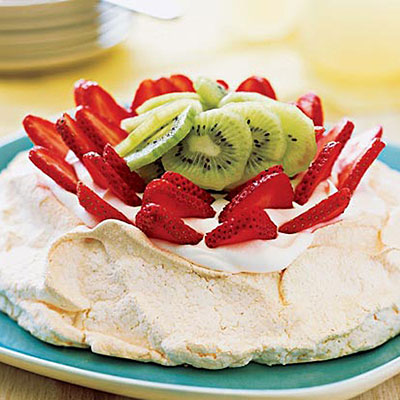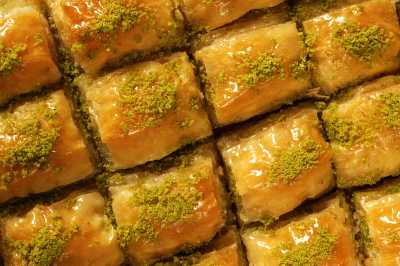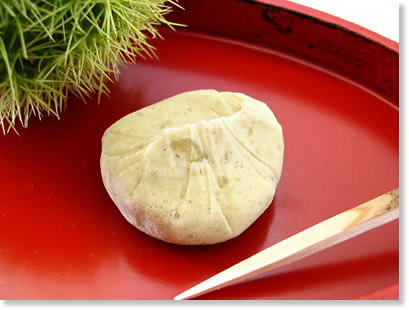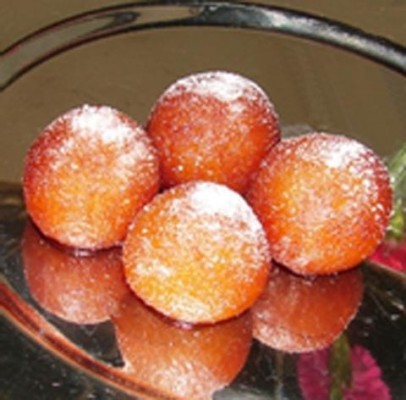1. Castle Pudding (England)
England is not known for its delicious food. In fact, people in England have left that island to seek tastier delights (and possibly better weather). But the English got it right in terms of this dessert. I am sure it is not uncommon for some people in England to just skip dinner to get to this warm, strawberry jelly sauced, scrumptious plate all the more sooner. What separates this pudding from the rest is the topping. The pudding is not what marvels one’s senses; it is the strawberry jam that is cascading down the sides of the pudding. These two textures were made for each other. Usually this type of pudding is baked in a dariole mold. This translates into the French verb “dorer” which means “cover in gold.” Sounds enticing! Photo: greatbritishpuddings.com
2. Pavlova (Australia and New Zealand)
This is a dessert preference in Australia, New Zealand and England. England takes a backseat here since it seems to be enjoyed a little more in the southern hemisphere. There is not any one kind of pavlova and it is not something sold on the street corner or in a convenience store. It is found in prestigious restaurants and some cake stores are known to carry this sweet delight. This is not a high caloric dessert so even Nicole Kidman can enjoy it. It is made from egg whites and sugar and, when cooked by someone who knows what they are doing in the kitchen (not me), the outside of the meringue shell will be crunchy. Whipped cream envelopes this dessert while the inside has a marshmallow like texture. It is served with any of these luscious fruits: strawberry, kiwi, raspberry or peach.
3. Baklava (Turkey)
This ambrosial dessert is now linked to Greece and Greek food settings, but it was first concocted in the Ottoman Empire inside Turkey. During this period, the Greeks and the Turks shared foods and ideas, including, but not limited to, this spectacular dessert known as Baklava. Kitchens should be kept humid and the cook needs to be prepared because Phyllo dough is used in the recipe. It can be tricky to manipulate: it is fine and dries very quickly. Honey, sugar, lemon juice, and orange water are used to make a syrup, which is poured over layers of phyllo dough and melted butter. Nuts are placed on top, usually pistachios, and the result is a thick but savory dessert. Photo: Ultimate Guide to Greek Food
4. Chestnut Kintons or Cream Candy (Japan)
Typically I would think that candy is more suitable for a movie theater, not dessert. However, I will make an exception for Japanese cream candy because it is so tasty. Chestnuts are the staple here, with sweet potatoes, sugar, mirin sauce and some vinegar. This chestnut is from a chestnut tree that is only found in Japan and South Korea. It is quite small, reaching only about 15 cm tall at the largest. This is a deciduous tree and the Japanese have taken advantage of Mother Nature’s offerings by creating a dessert candy that is delectable.
5. Gulaab Jamun (India)
Corn oil is preferable for this tasty dessert. Powder, regular milk, and perhaps some raisins or pistachios are most of the ingredients. This dough is divided into small balls and they will increase in size like donuts. These are not unlike the donut holes in the U.S., but instead of powdered sugar, sweet syrup is drizzled onto the soft dough. The syrup’s taste is indicative of where it is made in India. Some areas have a proclivity towards rose water, others lean toward saffron or citrus juice. This is not something that needs to be eaten quickly: Gulaab Jamun can be stored over night to absorb more syrup. Wow, how much sugar can one take? It depends on how strong the dough recipe is. This dessert, like pumpkin pie, can be served or eaten hot or cold. This dessert can also be delivered with even additional syrup layered on it. This is a traditional Indian dessert served on the holidays when firecrackers and celebrations are popping all around.










0 Comments